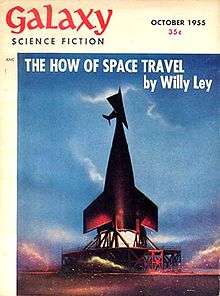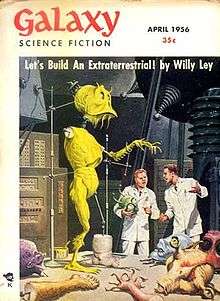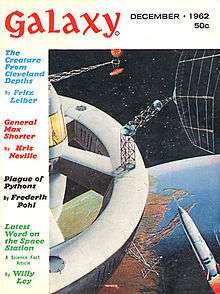Willy Ley
| Willy Ley | |
|---|---|
|
(left to right) Heinz Haber, Wernher von Braun, Willy Ley | |
| Born |
Willy Otto Oskar Ley October 2, 1906 Berlin, German Empire |
| Died |
June 24, 1969 (aged 62) Jackson Heights, New York[1] |
| Cause of death | Heart attack |
| Other names | Robert Wiley |
| Occupation | science writer and historian of science |
| Spouse(s) | Olga |
| Children | daughters Sandra and Xenia |
| Notes | |
|
US citizen (1944) Worldcon Guest of Honor (1953) | |
Willy Otto Oskar Ley (October 2, 1906 – June 24, 1969) was a German-American science writer, spaceflight advocate, and historian of science who helped to popularize rocketry, spaceflight, and natural history in both Germany and the United States. The crater Ley on the far side of the Moon is named in his honor.
Early life and Berlin years
Willy Otto Oskar Ley was the son of Julius Otto Ley, a traveling merchant, and Frida May, the daughter of a Lutheran sexton.[2] Ley grew up in his native Berlin during the First World War under the supervision of two aunts. When war erupted, his father was in Great Britain. Consequently, he spent the remainder of the war at a detention camp on the Isle of Man. Meanwhile, his mother worked as milliner in a distant city in Germany.
As Ley later recalled, he "grew up, so to speak, in the shadow of the Museum of Natural History in Berlin," where he spent Sundays exploring the exhibits and asking questions.[3] When his school teacher asked him to compose an essay on the subject "What Do I Want to Be When I Am Grown and Why?" Ley responded: "I want to be an explorer."[3] To his dismay, the teacher thought this silly, especially for someone of his family background. Plus, what was left to explore in the twentieth century?
Ley remained unconvinced by this skeptical attitude. When he was old enough, he studied astronomy, physics, zoology, and paleontology at the University of Berlin.[4] Ley explained, "I was never quite sure whether my studies would earn me the title of "zoologist" or "geologist," but I kept exploring, in a manner of speaking, looking especially into such corners as others had neglected."[5] He then became interested in spaceflight after reading Hermann Oberth's book Die Rakete zu den Planetenräumen ("The Rocket into Interplanetary Space"). Although it was a technical book that was difficult to understand, Ley worked through the calculations and concluded that outer space would soon become the next great frontier of human exploration. Ley was so convinced by Oberth's book that he sat down (at the age of 19) to write a popularization of its contents. He also began corresponding with every known rocket enthusiast in Europe, including Oberth himself. After publishing Die Fahrt ins Weltall ("Travel in Outer Space") in 1926, Ley became one of the first members of Germany's amateur rocket group, the Verein für Raumschiffahrt (VfR – "Spaceflight Society") in 1927 and wrote extensively for its journal, Die Rakete ("The Rocket"). Ley would eventually become the group's Vice-President, during a time when it had no active President. Meanwhile, he was writing hundreds of short articles about rockets for German and foreign newspapers.
Due to the influence of Ley and other popular science writers, such as Max Valier, Germans witnessed a short-lived "rocketry fad" in Berlin.[6] From exhibits at public locations to large spectator events, such as Fritz von Opel's rocket-car stunts, the German public was excited about both the future possibilities of space travel and the potential for new "weapons of wonder" that could revive the German Empire.
The "rocketry fad" culminated with Fritz Lang's 1929 film Die Frau im Mond ("Woman in the Moon"), which became the first realistic depiction of spaceflight in cinematic history. Although Oberth is often credited as the main technical consultant to the film, Ley's role was of central importance. Oberth was tasked with building a small rocket, to be launched at the film's premiere. This project never materialized. However, Ley's work on the movie did. As director Fritz Lang later recalled, "The work he had done as consultant and advisor... was amazing. The models of the spaceship, really a highly advanced model of a rocket, the trajectories and the orbits of the modular capsule from the earth, around the earth, and to the moon and back... were so accurate that in 1937 the Gestapo confiscated not only all models of the spaceship but also all foreign prints of the picture."[7]
Despite the many successes, the "rocketry fad" could not be sustained during the early years of the Great Depression. The German public lost interest amidst economic turmoil. Meanwhile, rocket researchers, such as Rudolf Nebel, formed closer ties with the military, which greatly expanded under the leadership of Wernher von Braun. With the collapse of the VfR, the rise of a culture of necessary secrecy, and the loss of public enthusiasm, Ley grew discouraged. He continued to write articles for the domestic and foreign press, while he stayed in touch with close friends. Yet, for the most part, Ley turned back to his original scientific interests, while writing a biography of Conrad Gessner (the "Father" of modern Zoology). To make ends meet, Ley also worked as a clerk and then manager at a Berlin bank.
When the Nazis seized power, Ley's situation became increasingly desperate. He was horrified by National Socialism, its ideology, and its style of violent politics. His perception of political events can be inferred from a short science fiction story called "Fog," which Ley wrote in 1940 under the pen name of Robert Wiley.[8] It is a biographical narrative about an office manager dealing with the everyday effects of totalitarianism. Although the story is set in New York City during a failed Communist revolution, it is clear that Ley is retelling his personal experiences in Berlin. In fact, John Campbell, the editor of Astounding, requested that Ley center the narrative on his personal experience.[9] Ley not only disliked the irrational nature of German politics, but he also associated the Nazis with the rise of "Pseudo-science."[10] To make matters worse, Ley had an established reputation as an international scientist, who openly shared and popularized technical information about rocketry, while his articles continued to be republished by foreign newspapers throughout 1934.
In January 1935, Ley used company stationery to write a letter that authorized his vacation in London.[11] Carrying only his favorite books, a few changes of clothing, and travel documentation, Ley fled Germany for Great Britain and ultimately the United States.
In the United States





In 1936, he supervised operations of two rocket planes carrying mail at Greenwood Lake, NY.[12] Ley was an avid reader of science fiction, and began publishing scientific articles in American science fiction magazines, beginning with "The Dawn of the Conquest of Space" in the March 1937 issue of Astounding Stories. In the February 1937 issue of that same magazine, he had published a science fiction short story "At the Perihelion" under the pseudonym Robert Wiley, which was later reprinted as "A Martian Adventure" in the 1962 anthology Great Science Fiction by Scientists (Collier Books, Groff Conklin, ed.). Ley had a regular science column called "For Your Information" in Galaxy Science Fiction from its premiere in October, 1950 until his death.[13] He was a member of science fiction fandom as well, attending science fiction conventions, and was eventually a Guest of Honor at Philcon II, the 1953 World Science Fiction Convention.
His book Rockets – the Future of Travel Beyond the Stratosphere (1944) describes the early rockets at VfR and more futuristic projects to reach the moon using a 3-stage rocket "as high as 1/3 of the Empire State Building" – a very good estimate of the height of the Saturn V rocket designed 20 years later. His works from the 1950s and '60s are regarded as classics of popular science and include The Conquest of Space 1949 (with Chesley Bonestell), The Conquest of the Moon (with Wernher von Braun and Fred Whipple, 1953), and Beyond the Solar System (1964). His book, Rockets, Missiles, and Space Travel, (1957) was cited in the Space Handbook: Astronautics and its Applications, a staff report of the Select Committee on Astronautics and Space Exploration of the U.S. House of Representatives, which provided non-technical information about spaceflight to U.S. policy makers.[14] Ley participated in "Man in Space", a 1955 episode of Disneyland which explained spaceflight to a large television audience.[15] Fellow Galaxy columnist Floyd C. Gale wrote that Ley "has become as familiar to TV audiences as Howdy Doody".[16] In the late 1950s, he designed for Monogram models a range of space vehicles. The kits included informational booklets on space travel written by Ley.[17] He also consulted for the Tom Corbett, Space Cadet series of children's science fiction books and TV series, as well as the 1959 feature film entitled "The Space Explorers." Robert A. Heinlein honored him by mentioning a future "Leyport" on the Moon in his 1952 juvenile novel The Rolling Stones.
In 1954, Ley wrote Engineers' Dreams in which he discussed 'Seven Future Wonders of the World'. These included accurate predictions of the Channel Tunnel between Britain and France and commercial wind, solar and geothermal power. Other schemes were less practical: damming the River Jordan to provide power and irrigation to Israel/Palestine and the plans of fellow German Herman Sörgel to drain the Mediterranean to link Europe with Africa and create the new continent of Atlantropa.
Ley was best known for his books on rocketry and related topics, but he also wrote a number of books about animals. One notable book was Exotic Zoology (1959), which combined some of his older writings with new ones. This is of some interest to cryptozoology, as Ley discusses the Yeti and sea serpents, as well as reports of relict dinosaurs. The book's first section (Myth?) entertains the possibility that some legendary creatures (like the sirrush, the unicorn or the cyclops) might be based on actual animals (or misinterpretation of animals and/or their remains).
He was a member of the all-male literary banqueting club the Trap Door Spiders, which served as the basis of Isaac Asimov's fictional group of mystery solvers the Black Widowers.
Ley died at the age of 62 on June 24, 1969 – less than a month before men first landed on the Moon –, in his home in Jackson Heights, Queens, where he had lived with his family since the mid-1950s.[18]
Publications[19]
- Die Fahrt ins Weltall. Hachmeister & Thal. 1926.
- Das Drachenbuch: Plaudereien von Echsen, Lurchen und Vorweltsaurien. Theringer Verlags-Anstalt/H. Bartholomaeus. 1927.
- Mars der Kriegsplanet. Hachmeister & Thal. 1927.
- Eiszeit. Theringer Verlags-Anstalt/H. Bartholomaeus. 1927.
- Konrad Gessner: Leben und Werk. Muenchner Drucke. 1929.
- Grundriss einer Geschichte der Rakete (small book). Hachmeister & Thal. 1932.
- Luftschutz-ABC. Hachmeister & Thal. 1934.
- The Lungfish and the Unicorn; an Excursion into Romantic Zoology. Modern Age Books. 1941.
- The Days of Creation; a Biography of Our Planet. Modern Age Books, NY. 1941.
- Bombs and Bombing. Modern Age Books, NY. 1941.
- Shells and Shooting. Modern Age Books, New York. 1942.
- Rockets; The Future of Travel Beyond the Stratosphere. Viking Press. 1944.
- The Lungfish, the Dodo, & the Unicorn: An Excursion Into Romantic Zoology (expanded edition of The Lungfish and the Unicorn). Viking Prss. 1948.
- (with Chesley Bonestell) (1949). The Conquest of Space.
- Dragons in Amber. Further adventures of a romantic naturalist. Sidgwick & Jackson. 1951.
- (with L. Sprague de Camp) (1952). Lands Beyond. Rinehart.
- (with Wernher Von Braun; et al. (1953). The Complete Book of Outer Space. Maco Magazine Corporation.
- Braun, Wernher von; Fred Lawrence Whipple; Willy Ley (1953) [1952 – Collier's Man on the Moon]. Cornelius Ryan, ed. Conquest of the Moon. illustrated by Chesley Bonestell, Fred Freeman, Rolf Klep. New York: The Viking Press.
- Engineers' Dreams. Viking Press. 1954. ISBN 978-9997483218.
- Salamanders and other Wonders. Viking Press. 1955.
- (with Wernher Von Braun) (1956). The Exploration of Mars. Viking Press.
- Ley, Willy (1957). Adventure in Space: Space Pilots. Guild Press.
- Man-Made Satellites. Guild Press. 1957.
- Space Pilots. Guild Press. 1957.
- (with Wernher Von Braun) (1957). The Complete Book of Satellites and Outer Space (2nd ed.). Maco Magazine Corporation.
- Ley, Willy (1958). Adventure in Space: Space Stations. Guild Press.
- Satellites, Rockets and Outer Space. New American Library. 1958.
- Ranger to the Moon. New American Library. 1958.
- Ley, Willy (1958) [1944]. Rockets, Missiles and Space Travel. New York: The Viking Press.
- Willy Ley's Exotic Zoology. Random House. 1959. ISBN 0-517-62545-8.
- Ley, Willy (1959). Mars and Beyond: A Tomorrowland Adventure, adapted for school use by Willy Ley. L. W. Singer.
- Ley, Willy (1959). Tomorrow the Moon: A Tomorrowland Adventure, adapted for school use by Willy Ley. L. W. Singer.
- Ley, Willy (1960). Rockets (published lectures). Doubleday.
- Ley, Willy (1961). Ballistics. Nelson Doubleday, New York.
- Ley, Willy (1961). Planets. Nelson Doubleday, New York.
- The Poles. LIFE Nature Library. 1962.
- Ley, Willy (1963) [1963]. Harnessing space. New York: MacMillan. p. 314.
- Watchers of the Sky: an Informal History of Astronomy From Babylon to the Space Age. Viking Press. 1963.
- Fire. Doubleday. 1963.
- Beyond the Solar System. Viking Press. 1964.
- Missiles, Moonprobes, and Megaparsecs. New American Library. 1964.
- Our Work in Space. MacMillan. 1964. ISBN 1-251-02668-0.
- Mariner IV to Mars. New American Library. 1966. ISBN 1-251-02668-0.
- Willy Ley's For Your Information: On Earth and in the Sky. DoubleDay. 1967.
- Willy Ley (1967). The Borders of Mathematics. Pyramid Publications, New York.
- Rockets, Missiles, And Men In Space (revision of "Rockets, Missiles, and Space Travel"). Signet/Viking. 1968. Signet 451-W3889, Library of Congress Catalog 67-20676.
- Inside the Orbit of the Earth. McGraw Hill. 1968.
- Dawn of Zoology. Prentice-Hall. 1968. ISBN 600-03-8663-X.
- Ley, Willy (1968). The Meteorite Craters /Illustrated by John Bierhorst. Weybright and Talley.
- Ley, Willy (1968). Discovery of the Elements. Delacourte.
- Another Look at Atlantis and Fifteen Other Essays. DoubleDay. 1969. ISBN 0-517-14543-X.
- Events in Space. Popular Library. 1969.
- Visitors from Afar: The Comets. McGraw Hill. 1969.
- Ley, Willy (1969). Gas Giants: The Largest Planets. McGraw-Hill, New York.
- Ley, Willy (1969). The Drifting Continents. Weybright and Talley.
- Ley, Willy (1971). Willy Ley's Worlds of the Past/Illustrated by Rudolph Zallinger. Golden Press, New York.
References and notes
- ↑ "Willy Ley Collection" (pdf). National Air and Space Archives. NASM archives.
- ↑ Sam Moskowitz, "Willy Ley: Forgotten Prophet of the Space Age," in Fantasy Review #99 (March 1987):12
- 1 2 Willy Ley, Exotic Zoology, vii
- ↑ Darling, David. "Willy Ley".
... fluent in German, English, Italian, French, and Russian
- ↑ Ley, Exotic Zoology, viii
- ↑ Michael J. Neufeld, "Weimar Culture and Futuristic Technology: The Rocketry and Spaceflight Fad in Germany, 1919–1933," in Technology and Culture 31:4 (October 1990): 725–752
- ↑ Fritz Lang, "Sci-Fi Film-maker's Debt to Rocket Man Willy Ley," Los Angeles Times, July 27, 1969, pg. P24
- ↑ Robert Wiley, "Fog," Astounding Science Fiction (December, 1940)
- ↑ Sam Moskowitz, "Willy Ley in the U.S.A.," Fantasy Review #100 (April, 1987): 17
- ↑ Willy Ley, "Pseudoscience in Naziland" Astounding Science Fiction 39/3(1947): 90–98
- ↑ Moskowitz, "Willy Ley: Forgotten Prophet," 12
- ↑ "History of rocketry". Retrieved 2008-06-13.
- ↑ GSF at search.com
- ↑ "Space Handbook: Astronautics and its Applications". NASA.
- ↑ Ley, Willy (October 1955). "For Your Information". Galaxy. p. 60. Retrieved 16 December 2013.
- ↑ Gale, Floyd C. (January 1956). "Galaxy's 5 Star Shelf". Galaxy. p. 90. Retrieved 16 December 2013.
- ↑ "Thrills in Space! with Willy Ley Space Models". Galaxy (advertisement). December 1959. pp. 46–47. Retrieved 15 June 2014.
- ↑ via United Press International. "Space Scientist Willy Ley Dies", Milwaukee Sentinel, June 25, 1969. Accessed May 28, 2009.
- ↑ "Ley, Willy (1906–1969) [list of books]". WolframResearch. Retrieved 2008-10-06.
Further reading
- Geppert, Alexander C. T. (2008). "Space Personae: Cosmopolitan Networks of Peripheral Knowledge, 1927–1957". Journal of Modern European History. 6 (2): 262–286.
External links
- Works by Willy Ley at Project Gutenberg
- Works by or about Willy Ley at Internet Archive
- Willy Ley at the Internet Speculative Fiction Database
- A film clip "Longines Chronoscope with Dr. Willy Ley (August 4, 1952)" is available at the Internet Archive
- Disneyland - Man in Space - Part 1 of 4. Video in which Dr. Ley explains principles of rocketry at 11:36
.jpg)